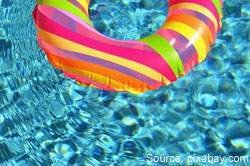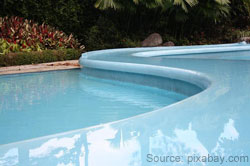
During the summer, your pool is likely your main source of
fun, excitement and relaxation. Whether you're spending a nice, quiet afternoon
floating gently on a raft and sipping a nice cold drink or whether you're having
a big backyard get-together, when the temperature rises, your pool becomes the
center of attention - the life of the party.
However, your pool is also
likely one of your biggest investments and not only cost a lot to install but a
lot to maintain as well. And if anything goes wrong, it will likely cost a lot
to repair as well. That's why it's so important for pool owners to keep up with
the maintenance that is required throughout the summer months to make sure the
pool stays in top shape.
Owning a pool is a lot of work, and it takes a
fair amount of dedication to keep the pool in working order, keep the water
clean and keep the chemicals at the required levels so you can continue to enjoy
the relaxing embrace of the cool water on a hot, humid summer day. As with any
other part of your home, failure to properly maintain your pool and falling
behind on the daily and weekly upkeep of the area in and around the pool can
cause things to deteriorate pretty quickly, possibly costing you hundreds or
even thousands of dollars in repairs or professional maintenance.
To
prevent yourself from having to break the bank to get your pool repaired and
wasting precious time that you could be spending in it, enjoying all it has to
offer, you should keep a checklist handy that outlines the daily and weekly
maintenance that is required in order to keep your pool running smoothly and
cleanly. To download a checklist you can use to stay organized and up-to-date
with your pool maintenance, click
here.
When you open the pool
Opening your pool after a long, cold
winter is one of the best parts about the beginning of the summer season.
However, before you can jump in and enjoy the water, there's a lot of work to be
done. After sitting there all winter, your pool is most likely going to be
pretty dirty, filled with leaves, branches, dirt, sediment and pretty much
anything else that managed to slip under the cover during those winter
months.
After you've taken the cover off, cleaned it and stored it away
for the summer, your first task is to thoroughly vacuum the pool. The vacuum
will clean up all of the leaves and sediment that have sunk to the bottom of the
pool and give it that murky, brown color. Once that's clean, the water will
begin to look clearer. Your next step is to skim the surface of the pool and
clear out any remaining debris.
Next, you'll need to clean the pool's
siding and tiles to remove any algae build-up that may have accumulated over the
winter and then add water until the water level reaches the desired height.
Before you're ready to open the pool, the final step is to test the water
balance and the pH levels and then shock the pool with chlorine so that the
water is clean and safe to swim in. Lastly, thoroughly examine all of the pool's
filters, skimmers, drains, ladders, diving boards, hand rails, and pumps to make
sure they are functioning properly.
Daily maintenance
So your pool is open for business and you're
ready to enjoy it, just in time for the heat of summer to swoop in. But don't
get too relaxed just yet, there's still plenty of work that needs to be done on
both a daily basis and a weekly basis to maintain it and make sure that you'll
be able to enjoy your pool for as long as you'd like.
Here is a rundown
of some of the things you should be checking for each day:
 Check the pH level of the water. In chlorine pools,
you must consistently monitor the pH level of the water to make sure that it is
maintaining the proper level of acidity. Too much acidity in the water can be
harmful to swimmers, so testing your pH level at least once a day will ensure
that it remains at safe levels. If the levels are off, there are pH balancers
that you can add to the water to balance out the acidity levels.
Check the pH level of the water. In chlorine pools,
you must consistently monitor the pH level of the water to make sure that it is
maintaining the proper level of acidity. Too much acidity in the water can be
harmful to swimmers, so testing your pH level at least once a day will ensure
that it remains at safe levels. If the levels are off, there are pH balancers
that you can add to the water to balance out the acidity levels.
- Check the chlorine level of the water. Chlorine helps keep bacteria
from growing in your pool and keeps the water clean and safe for people to swim
in. You should check your chlorine levels at least once a day to make sure there
is enough chlorine in the pool. If the chlorine levels are low, you can add more
chlorine to the water. However, be careful of adding too much, as high levels of
chlorine can be irritating to your skin and your eyes when swimming.
- Check the filter and remove any debris. Checking your filters should
also be a daily occurrence, as well as cleaning out the strainer baskets and
removing any debris from them. Also make sure to check the filter pressure to
check for any clogs that could damage your filter.
- Skim the surface of the pool. This is one of the simplest maintenance
tasks and can be performed before using the pool each day, or even while you're
in the pool if you'd like. It requires you to run a mesh net over the surface of
the water to remove any leaves, insects, dirt or other debris that gets into the
pool over the course of a typical day or night, and helps keep the water clean
and prevent debris from sinking to the bottom of the pool.
Weekly maintenance
Other aspects of your pool maintenance
routine need not be performed daily, and instead can be checked up on once a
week or even once every few weeks, depending on how often you use your pool and
what kind of pool you have.
Here are some of the things you should check
for on a weekly or bi-weekly basis:
- Clean tiles and walls of the pool and clear all algae that has built
up
- Check the walls and the lining of the pool for any tears, cracks or other
signs of wear or damage and repair if necessary
- Clean the pool deck thoroughly with hose or power washer
- If possible, keep pool covered when not in use to prevent evaporation and
to keep debris from falling into the pool.
- Check all of the steps, ladders, handrails and other safety equipment in
the pool to ensure they are in full working order
- For saltwater pools, test the salt levels
- Make sure the water level is high enough and that the pump is functioning
correctly
- Remove any debris from the bottom of the pool such as dirt, leaves or
other accumulations